Town in Connecticut, United States
| Wallingford | |
|---|---|
| Town | |
| Town of Wallingford | |
 Downtown Wallingford Downtown Wallingford | |
 Flag Flag Seal Seal | |
| Motto: "A Great New England Town" | |
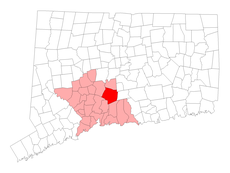 New Haven County and Connecticut New Haven County and Connecticut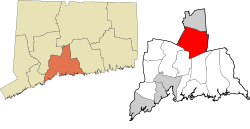 South Central Connecticut Planning Region and Connecticut South Central Connecticut Planning Region and Connecticut | |
| Show WallingfordShow ConnecticutShow the United States | |
| Coordinates: 41°27′23″N 72°48′15″W / 41.45639°N 72.80417°W / 41.45639; -72.80417 | |
| Country | United States |
| U.S. state | Connecticut |
| County | New Haven |
| Region | South Central CT |
| MSA | Greater New Haven |
| CSA | New York |
| Established | 1670 |
| Government | |
| • Type | Mayor-council |
| • Mayor | Vincent Cervoni (R) |
| • Town Council |
|
| Area | |
| • Total | 39.9 sq mi (103.3 km) |
| • Land | 39.0 sq mi (101.1 km) |
| • Water | 0.9 sq mi (2.2 km) |
| Elevation | 151 ft (46 m) |
| Population | |
| • Total | 44,396 |
| • Density | 1,100/sq mi (430/km) |
| Time zone | UTC−5 (Eastern) |
| • Summer (DST) | UTC−4 (Eastern) |
| ZIP Codes | 06492, 06493 |
| Area code(s) | 203/475 |
| FIPS code | 09-78740 |
| GNIS feature ID | 0213522 |
| Website | www |
Wallingford is a town in New Haven County, Connecticut, United States, centrally located between New Haven and Hartford, and Boston and New York City. The town is part of the South Central Connecticut Planning Region and the New York Metropolitan Area. The population was 44,396 at the 2020 census. The community was named after Wallingford, in England.
History
Wallingford, Connecticut, is deeply woven into the fabric of early American history, from its founding to its connection with some of the most influential figures of the colonial era. Established on October 10, 1667, by the Connecticut General Assembly, Wallingford was founded by a group of 38 planters and freemen, including notable figures such as John Moss, Samuel Street, and Robert Wallace. These early settlers chose a strategic location near the Quinnipiac River, which is now the area known as Main Street. By May 12, 1670, the settlement had grown to include 126 residents living in temporary housing, and by 1675, 40 permanent homes had been constructed, signaling the town's early growth and stability.
One of Wallingford’s early settlers was Thomas Yale, an influential figure in the New Haven Colony and an ancestor of Elihu Yale, the benefactor after whom Yale University is named. Thomas Yale was a signatory of the Wallingford plantation covenant in 1667, marking the formal establishment of the town.
Wallingford’s historical significance extends to its involvement in key moments of colonial America. In 1697, the town became the site of New England's last witchcraft trial when Winifred Benham was accused of witchcraft. She was tried three times in Wallingford but was acquitted on each occasion, marking the end of the witch trials in the region. This event reflects the lingering fears and superstitions of the era, even as the fervor of the Salem witch trials had begun to fade.
The town also played a critical role in America’s fight for independence, with Lyman Hall being one of its most distinguished sons. Born in Wallingford in 1724, Lyman Hall went on to become a prominent physician and statesman who represented Georgia in the Continental Congress. Hall was one of the signers of the Declaration of Independence, underscoring Wallingford’s deep ties to the founding of the United States. His contributions to the Revolutionary cause exemplify the town’s commitment to the ideals of liberty and self-governance.
As Wallingford entered the 19th century, it began to transform from an agricultural community into an industrial hub. The arrival of the railroad in the 1840s, specifically the New Haven and Hartford Railroad (later part of the New York, New Haven, and Hartford Railroad), further accelerated the town's growth. The railroad connected Wallingford to larger markets in the Northeast, facilitating the transport of goods, including the town's famous silver products, and spurring the development of new industries.
Wallingford became particularly renowned for its silver production, with companies like Hall, Elton & Co., Simpson, Hall, Miller & Co., and R. Wallace & Sons gaining national prominence. One of the key figures in this industry was Samuel Simpson, a local industrialist and philanthropist who played a pivotal role in Wallingford’s rise as a center of silver manufacturing. Simpson, Hall, Miller & Co., which he co-founded, became one of the leading producers of silverware in the country. Samuel Simpson’s contributions were instrumental in establishing Wallingford as a major hub for silver production. His company eventually became part of the International Silver Company, headquartered in the neighboring city of Meriden, which solidified the region's status as a global center for silver manufacturing.
In the 19th century, Wallingford was also the birthplace of Moses Y. Beach, a prominent figure in American journalism. Born in 1800, Beach became the owner of the New York Sun and was known for pioneering the "penny press," making newspapers affordable to the general public. He is also credited for being a leading founder of the Associated Press.
However, Wallingford was not immune to tragedy. On August 9, 1878, a devastating tornado struck the town, leaving a path of destruction and claiming the lives of at least 29, and possibly as many as 34, residents. This tornado remains the deadliest in Connecticut's history, and the disaster left a lasting impact on the community.
The 20th century marked a period of suburbanization for Wallingford, as the town transitioned from an industrial hub to a residential community while retaining its economic diversity. The post-World War II era saw significant growth in Wallingford’s population, driven by the suburban boom that reshaped much of America. New housing developments sprang up, attracting families looking for a balance between the conveniences of city life and the charm of a smaller town.
Despite the suburbanization, Wallingford continued to attract businesses, maintaining a robust economic base. The town became a hub for various industries, including medical, healthcare, high-tech specialty manufacturing, and research and development. The development of several industrial parks—Barnes Industrial Park, Casimir Pulaski Industrial Park, Centract Park, and MedWay Industrial Park—helped attract a wide range of businesses, further diversifying Wallingford's tax base. The establishment of an Interchange Zone at the intersection of Interstate 91 and Route 68 facilitated the growth of office parks, research centers, and hotels, cementing Wallingford's role as a key economic center in the region.
One of the most significant industrial presences in Wallingford during the late 20th and early 21st centuries was the Bristol-Myers Squibb Company. The pharmaceutical giant established a research and development facility in Wallingford's MedWay Industrial Park, becoming the town's largest taxpayer and a key contributor to its economy. However, in 2017, Bristol-Myers Squibb relocated its operations, and the facility was subsequently demolished in 2018.
-
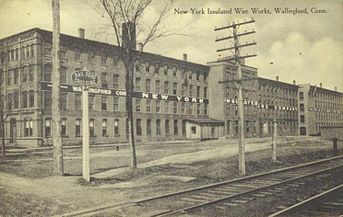 New York Insulated Wire Company, 1910.
New York Insulated Wire Company, 1910.
-
 Library and Marlborough House, c. 1909.
Library and Marlborough House, c. 1909.
-
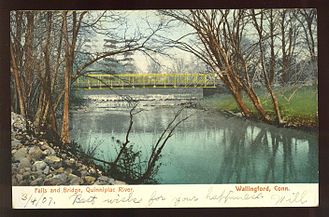 Bridge and falls at Quinnipiac River in Wallingford, 1907.
Bridge and falls at Quinnipiac River in Wallingford, 1907.
Education
Wallingford is served by the Wallingford Public School District, which includes several elementary schools, two middle schools (Dag Hammarskjold and James H. Moran), and two high schools (Mark T. Sheehan and Lyman Hall). The district offers a range of academic programs, including Advanced Placement courses, STEM education, and arts programs. Lyman Hall High School features a specialized agricultural science program. The district also provides special education services, English language learning programs, and a variety of sports programs, including football, soccer, basketball, and track and field.

Private schools
Wallingford is also home to three private schools:
- Choate Rosemary Hall, a private, co-educational, college-preparatory boarding school
- Heritage Baptist Academy
- Holy Trinity School
Geography
According to the United States Census Bureau, the town has a total area of 39.9 square miles (103.3 km), of which 39.0 square miles (101.1 km) is land and 0.9 square miles (2.2 km), or 2.16%, is water.
The town of Wallingford sits astride the Quinnipiac River in northern New Haven County, roughly 90 miles northeast of New York City. It is 5 miles (8 km) south of Meriden and about 13 miles (21 km) north of New Haven. Towns bordering Wallingford are Cheshire, Durham, Hamden, Meriden, Middlefield, North Branford and North Haven. Situated in the Hartford-New Haven-Springfield corridor, Wallingford is traversed by U.S. Route 5, Interstate 91, and State Highways Route 15 (Wilbur Cross Parkway), Route 68, Route 71 and Route 150.
Principal communities
- East Wallingford
- Quinnipiac (partly in North Haven)
- Tracy
- Wallingford Center
- Yalesville
Demographics
| Census | Pop. | Note | %± |
|---|---|---|---|
| 1820 | 2,237 | — | |
| 1850 | 2,595 | — | |
| 1860 | 3,206 | 23.5% | |
| 1870 | 3,676 | 14.7% | |
| 1880 | 4,686 | 27.5% | |
| 1890 | 6,584 | 40.5% | |
| 1900 | 9,001 | 36.7% | |
| 1910 | 11,155 | 23.9% | |
| 1920 | 12,010 | 7.7% | |
| 1930 | 14,278 | 18.9% | |
| 1940 | 14,788 | 3.6% | |
| 1950 | 16,976 | 14.8% | |
| 1960 | 29,920 | 76.2% | |
| 1970 | 35,714 | 19.4% | |
| 1980 | 37,274 | 4.4% | |
| 1990 | 40,822 | 9.5% | |
| 2000 | 43,026 | 5.4% | |
| 2010 | 45,135 | 4.9% | |
| 2020 | 44,396 | −1.6% | |
| U.S. Decennial Census | |||
As of 2022, Wallingford is home to approximately 44,446 residents. The racial makeup leans white (80.2%), with a notable Hispanic presence (11.6%) and smaller proportions of Asian (4.4%) and other groups. The median age sits at 44.3, indicating a blend of families and young professionals. Family households comprise 63% of the total, with 24% having children under their roof.
Wallingford’s 2023 median household income was $101,572, and the median family income was $123,493. The average household and family income was $120,987 and $145,477 respectively. Compared to the national average, Wallingford's median income is significantly higher, putting it in the top 25% of U.S. households.
Economy
Top employers
Top employers in Wallingford according to the town's 2022 Comprehensive Annual Financial Report:
| # | Employer | # of Employees |
|---|---|---|
| 1 | Town of Wallingford | 1,478 |
| 2 | Anthem BC/BS | 1,225 |
| 3 | Gaylord Hospital | 529 |
| 4 | Community Health Network of CT | 438 |
| 5 | Masonic Healthcare Center | 417 |
| 6 | Choate Rosemary Hall | 299 |
| 7 | Ulbrich Stainless Steels & Special Metals, Inc. | 215 |
| 8 | BYK | 197 |
| 9 | Thurston Foods Inc | 169 |
| 10 | Fosdick Fulfillment Corp | 157 |
Transportation

Mass transit
Wallingford is also located on the New Haven–Springfield Line, with daily passenger service to points north and south, providing direct access to New York City along with Boston via a connection in New Haven. It is served at Wallingford station by the CT Rail (Connecticut Department of Transportation) Hartford Line trains and by Amtrak's Hartford Line, Northeast Regional, and Valley Flyer.
Airports
Tweed New Haven Airport (HVN) in East Haven, Westchester County Airport in Westchester County, and Bradley International Airport (BDL) in Windsor Locks are the closest commercial airports to Wallingford.
Municipal electric utility
The Wallingford Electric Division (WED) is a municipally owned utility that provides electricity to the town. Established in 1899, WED is one of Connecticut's few municipal electric utilities, operating under the town's governance. It supplies electricity to residents and businesses, and is known for offering reliable service at competitive rates.
WED is responsible for the generation, distribution, and maintenance of the town's electrical infrastructure, focusing on efficiency and reliability. The Wallingford Electric Division is overseen by the Public Utilities Commission of Wallingford, which manages its operations, finances, and strategic planning. The division's mission is to deliver cost-effective, dependable electric service while meeting the evolving needs of the community.
Sports
In 1943 and 1944 the Boston Braves held spring training in Wallingford at Choate's Winter Exercise Building. The town is the home of the Connecticut Bearcats, a New England Football League team.
Notable people
- Erich Auerbach, German philologist
- Moses Yale Beach, American inventor, entrepreneur, philanthropist and publisher, who started the Associated Press, and is credited with originating print syndication
- William Yale Beach, early banker of Wallingford, real estate developer in the city, son of Moses Yale Beach
- Stephen R. Bradley, United States Senator
- Michael Buckley, YouTuber
- Mary Atwater Choate, cofounded Choate Rosemary Hall
- William Gardner Choate, American judge, cofounded Choate Rosemary Hall
- Bates Cooke, US Congressman
- D.J. Cotrona, actor
- Pasquale DeBaise (1926–2022), businessman and Connecticut state legislator
- Beverly Donofrio, author
- Morton Downey, singer, businessman
- Morton Downey, Jr. (1932–2001), talk show host
- Lauren Geremia, interior designer
- Robert Gober, influential contemporary artist
- Lyman Hall, an American Founding Father, physician, clergyman, statesman, and Declaration of Independence signatory
- Dorothy Kosinski, art scholar
- Raoul Lufbery, World War I flying ace
- John A. McGuire, member of the United States House of Representatives
- Art Nugent, cartoonist, creator of Uncle Art's Funland
- Jay Allen Sanford, author and cartoonist
- Samuel Simpson, silversmith industrialist and entrepreneur
- Hilton Valentine (1943–2021), musician associated with The Animals, moved to Wallingford in 1977
- Theophilus Yale, captain, magistrate and early settler of Wallingford
- Elihu Yale, captain, pioneer bayonet manufacturer in Connecticut
- Charles Dwight Yale, Connecticut State Senator, businessman, co-proprietor of Simpson, Hall, Miller & Co.
- Thomas Yale, one of the cofounders of Wallingford, son of Capt. Thomas Yale
Points of interest

National Register of Historic Places
Ten buildings and districts in Wallingford are listed on the National Register of Historic Places:
- Center Street Cemetery, added August 1, 1997
- Franklin Johnson House, added November 23, 1998
- John Barker House, added August 3, 1974
- Joseph Blakeslee House, added April 13, 1998
- Nehemiah Royce House, added August 24, 1998
- Samuel Parsons House, added April 12, 1982
- Samuel Simpson House, added June 18, 1986
- Theophilus Jones House, added January 30, 1992
- Wallingford Center Historic District, added December 2, 1993
- Wallingford railroad station, added November 19, 1993
Citations
- "Town of Wallingford, Connecticut". Town of Wallingford, Connecticut. Retrieved September 22, 2012.
- "Census - Geography Profile: Wallingford town, New Haven County, Connecticut". United States Census Bureau. Retrieved December 22, 2021.
- The Connecticut Magazine: An Illustrated Monthly. Connecticut Magazine Company. 1903. p. 335.
- Davis, Charles Henry Stanley (1870). History of Wallingford, Conn., from its settlement in 1670 to the present time, including Meriden, which was one of its parishes until 1806, and Chesire, which was incorporated in 1780. University of California Libraries. Meriden, Conn. : The Author.
- "Home - Wallingford Public Schools". www.wallingford.k12.ct.us. September 2, 2024. Retrieved August 31, 2024.
- "Home - Choate Rosemary Hall". Choate.edu. Retrieved August 23, 2016.
- "Home | Heritage Baptist Church". Hbc4.me. Retrieved August 23, 2016.
- "Census of Population and Housing". Census.gov. Retrieved June 4, 2015.
- "U.S. Census Bureau QuickFacts: Wallingford town, South Central Connecticut Planning Region, Connecticut". www.census.gov. Retrieved January 18, 2024.
- "Explore Census Data". data.census.gov. Retrieved December 13, 2024.
- "Explore Census Data". data.census.gov. Retrieved December 13, 2024.
- "Town of Wallingford Comprehensive Annual Financial Report For the Fiscal Year July 1, 2022- June 30, 2023" (PDF). Town of Wallingford. Retrieved February 18, 2024.
- The ESPN Baseball Encyclopedia. Sterling Publishing. 2007. p. 1789. ISBN 978-1-4027-4771-7.
- "BRADLEY, Stephen Row, (1754 - 1830)". Biographical Directory of the United States Congress. Retrieved January 13, 2014.
- "COOKE, Bates, (1787 - 1841)". Biographical Directory of the United States Congress. Retrieved January 13, 2014.
- "D.J. Cotrona". TV.com. Retrieved January 13, 2014.
- Pasquale J. DeBaise-obituary
- "Donofrio's Unique Life Is, at Last, a Film". Los Angeles Times. October 19, 2001. Retrieved January 13, 2014.
- Galon, Buddy (2005). Dearly Departed: A Personal View of Celebrity Funerals. AuthorHouse. p. 51. ISBN 9781463488215.
- Bradley, Edwin M. (2004). The First Hollywood Musicals: A Critical Filmography of 171 Features, 1927 Through 1932. McFarland. p. 31. ISBN 9780786420292.
- Shulman, Ken. "Team Works". Metropolis Magazine. Retrieved March 13, 2015.
- "Phillips Collection Taps Dallas Curator To Succeed Director". The Washington Post. Retrieved January 13, 2014.
- "World War I Flying Ace Raoul Lufbery". ConnecticutHistory.org#sthash.IEibE0Y1.dpuf. Retrieved January 13, 2014.
- "McGUIRE, John Andrew, (1906 - 1976)". Biographical Directory of the United States Congress. Retrieved January 13, 2014.
- "San Diego Reader staff bios". San Diego Reader. Retrieved February 16, 2015.
- Davison, Phil. "The Animals guitarist Hilton Valentine dies at 77". The Washington Post. Retrieved March 1, 2021.
- "National Register Information System". National Register of Historic Places. National Park Service. March 13, 2009.
General references
- Davis, Charles Henry Stanley (1870). History of Wallingford, Conn., from Its Settlement in 1670 to the Present Time, Including Meriden, which was One of Its Parishes until 1806, and Cheshire, which was Incorporated in 1780. Meriden, CT: Charles Henry Stanley Davis.
- Gillespie, Charles Bancroft (1895). Souvenir History of Wallingford, Connecticut, 1895. New Haven, CT: Journal Publishing Co.
- Kendrick, John B. (1878). History of the Wallingford Disaster. Hartford, CT: Case, Lockwood and Brainard Co.
External links
- Town of Wallingford official website
- Maps of Wallingford (1881–1919) online
- History books on Wallingford (1870–1918) online
| Municipalities and communities of New Haven County, Connecticut, United States | ||
|---|---|---|
| County seat: New Haven | ||
| Cities | 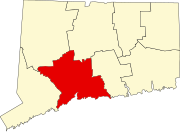 | |
| Towns | ||
| Boroughs |
*Consolidated borough and town | |
| CDPs | ||
| Other communities | ||
| Municipalities and communities of South Central Connecticut Planning Region, Connecticut, United States | ||
|---|---|---|
| Cities | 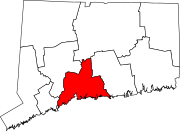 | |
| Towns | ||
